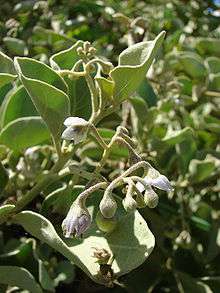Solanum nelsonii
| Solanum nelsonii | |
|---|---|
 | |
| Scientific classification | |
| Kingdom: | Plantae |
| (unranked): | Angiosperms |
| (unranked): | Eudicots |
| (unranked): | Asterids |
| Order: | Solanales |
| Family: | Solanaceae |
| Genus: | Solanum |
| Species: | S. nelsonii |
| Binomial name | |
| Solanum nelsonii | |
| Synonyms | |
|
See text | |
Solanum nelsonii[1] (often misspelled Solanum nelsoni), common names pōpolo[2] and Nelson's horsenettle,[3] is a partially woody sprawling shrub-like perennial plant in the Solanaceae family, part of the Solanum or nightshade genus. This poisonous plant is endemic to the Pacific Islands. It grows low in coastal sites in coral rubble to pure sand.
Solanum nelsonii was listed as an endangered species wherever found by the U.S. Fish and Wildlife Service on September 30, 2016.[4] Pōpolo is used in restoration projects around the state of Hawaii and the Northwest Hawaiian Islands.
.jpg)
Nelson's horsenettle was first described by Michel Félix Dunal. The scientific name Solanum nelsonii has also – invalidly – been given to two other species of nightshade:
- S. nelsonii of Zipp. based on Span. is the S. violaceum described by Ortega.
- S. nelsonii of Correll is S. oxycarpum.
Several varieties of Nelson's horsenettle have been described, but they are not usually considered valid anymore:
- Solanum nelsonii var. acuminatum F.Br. in Christophersen & Caum
- Not to be confused with S. acuminatum as described by Ruiz & Pavón Jiménez.
- Solanum nelsonii var. caumii F.Br. In Christophersen & Caum
- Solanum nelsonii var. intermedium F.Br. in Christophersen & Caum
- Not to be confused with S. intermedium as described by Otto Sendtner in C.F.P. von Martius.
- Solanum nelsonii var. thomasiifolium Seem.[5]
- Not to be confused with S. thomasiifolium.
- Solanum nelsonii var. typicum F.Br. in Christophersen & Caum
- Solanum nelsonii var. vadosum H.St.John
References
| Wikimedia Commons has media related to Solanum nelsonii. |
- ↑ De Candolle (1952). Prodromus Systematis Naturalis Regni Vegetabilis. 13. p. 123 – via Missouri Botanical Garden.
S. NELSONI, ramis teretibus tomentosis flavo-ferrugineis, foliis ntrinque tomentosis petiolatis cordato-ovatis, subtus candicantibus subnervosis, supra ferrugineis auriculatis, racemis simplicibus suboppositifoliis folio Iongioribus.— In insulis Sandwich (David Nelson, in h. Banks). Lignosum, Petioli basi auriculati, foliis parvis, subsessilibus, ovato-orbicularibus, subcordatis, axillaribus. Pedunculi, pedicelli calycesque tomentosi, ferruginei. Flores pedicellati, cymosi. Calyx tomentosus, 5-fidus, laciniis angustis. Corolla calyce vix duplo longior, extus tomentosa. (v. s. in h. Banks, anno 1819.)
- ↑ "Native Plants Hawaii". nativeplantshawaii.edu. Retrieved January 12, 2017.
- ↑ "Solanum nelsonii". Natural Resources Conservation Service PLANTS Database. USDA. Retrieved 17 November 2015.
- ↑ "Endangered and Threatened Wildlife and Plants; Endangered Status for 49 Species From the Hawaiian Islands" (PDF). Federal Register. U.S. Fish and Wildlife. 81: 67786–67860. September 30, 2016.
We, the U.S. Fish and Wildlife Service (Service), determine endangered status under the Endangered Species Act of 1973 (Act), as amended, for 10 animal species, ..., and for 39 plant species from the Hawaiian Islands. This rule adds these species to the Federal Lists of Endangered and Threatened Wildlife and Plants.
- ↑ "ITIS Report". Integrated Taxonomic Information System. Retrieved January 12, 2017.
Footnotes
| Wikispecies has information related to Solanum nelsonii |
- Solanaceae Source [2008]: Solanum nelsoni. Retrieved 2008-SEP-26.
Further reading
- "Solanum nelsonii (popolo) From Molokai at State nursery Kahului, Maui". Plants of Hawaii. Images by Forest & Kim Starr. 23 May 2003. Archived from the original on 12 August 2012.
- Badami S, Prakash O, Dongre SH, Suresh B (2005). "In vitro antioxidant properties of Solanum pseudocapsicum leaf extracts". Indian J Pharmacol. 37 (4): 251–2. doi:10.4103/0253-7613.16573.
- Evenhuis, Neal L.; Eldredge, Lucius G., eds. (2004). Natural History of Nihoa and Necker Islands. Bulletin in environmental and cultural studies. Bishop Museum Press. pp. 67–68. ISBN 158178029X.
- Culliney, John L. (2006). Islands in a Far Sea: The Fate of Nature in Hawai'i. University of Hawai'i Press. p. 147. ISBN 978-0-8248-2947-6.
